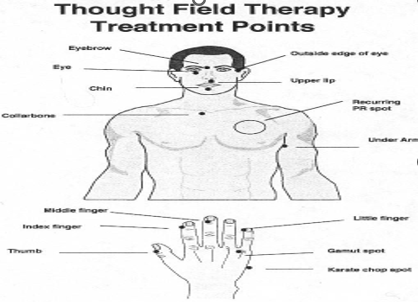“TFT creates an imaginary, though quite real scaffold, upon which we may erect our explanatory notions”
-Roger Callahan

Image Courtesy of https://www.pinterest.co.uk/pin/108508672242226792/
Summary:
Thought Field Therapy (TFT) is a fringe psychological treatment developed by American psychologist Roger Callahan. It is a conscious state distraction form of treatment with links to the ancient Chinese philosophy of “chi”, which is thought to be the ‘life force’ that flows throughout the body.
TFT claims to help mental and physical ailments through specialized “tapping” with the fingers at meridian points on the upper body and hands.
Detail:
Here are some tips on how to get the best mental health results from Thought Field Therapy:
• Find a certified Thought Field Therapy practitioner: It is important to work with a trained professional who can guide you through the therapy process and ensure that you are doing it correctly.
• Identify the issue: Identify the specific issue that you want to address using Thought Field Therapy. It could be anxiety, depression, phobias, or any other emotional or psychological issue.
• Focus on the issue while tapping: While tapping on the meridian points, focus on the specific issue that you want to address. This can help you to clear the negative emotions associated with the issue.
• Be open to the process: Have an open mind and be willing to try something new. Thought Field Therapy may seem unconventional, but many people have reported significant improvements in their mental health as a result of using it.
• Practice regularly: Consistency is key with Thought Field Therapy. It is recommended to practice tapping on a regular basis, either with a practitioner or on your own.
• Monitor your progress: Keep track of your progress and any changes you notice in your mental health. This can help you to determine if Thought Field Therapy is working for you and whether you need to adjust your approach.
• Combine with other therapies: While Thought Field Therapy can be effective on its own, it can also be combined with other therapies such as counseling, medication, or mindfulness practices for even better results.
Skill:
Here is a general outline of a TFT routine:
- Identify the problem: The first step is to identify the issue that is causing emotional distress, such as anxiety, fear, anger, or sadness. This can be done by focusing on the feelings, thoughts, or physical sensations associated with the problem.
- Rate the intensity: Next, rate the intensity of the problem on a scale from 0-10, with 0 being no intensity and 10 being the highest intensity.
- Choose a setup statement: Choose a setup statement that acknowledges the problem and affirms self-acceptance. An example of a setup statement is “Even though I feel anxious about [problem], I deeply and completely accept myself.”
- Tap on the karate chop point: Tap on the karate chop point, located on the fleshy part of the hand between the base of the pinky finger and the wrist, while repeating the setup statement three times.
- Tap on the acupressure points: Tap on a series of acupressure points on the body, in a specific order, while repeating a reminder phrase that acknowledges the problem. The acupressure points are as follows: eyebrow, side of eye, under eye, under nose, chin, collarbone, underarm, and top of head. The reminder phrase could be a simple statement such as “this anxiety” or “this fear”.
- Re-rate the intensity: After tapping on all the points, rate the intensity of the problem again on the 0-10 scale.
- Repeat the process: If the intensity of the problem has decreased but is still present, repeat the process by choosing a new setup statement and tapping on the acupressure points again. If the intensity has decreased to a manageable level, the routine is complete.
It is important to note that TFT should be done under the guidance of a trained practitioner, as they can provide specific guidance on how to tailor the routine to address individual needs and concerns.
Action:
Do
Difficulty:
Medium
Speed:
Fast
Other Compatible Coping Skills
How many stars would you award this coping skill?
